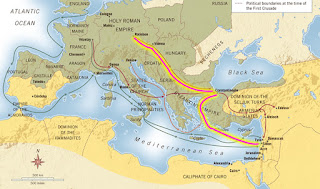By the end of two centuries, the crusades were FINALLY over! The Holy land was divided into small sections. The sections that where Christian-occupied where called the Crusader States.
Friday, December 2, 2016
Thursday, December 1, 2016
The Kiddy Crusade
Though the Children's Crusade is said to be a myth, it could have very we'll been so. As is believed, two long boys, around the age of 12. It has been said that each of them rallied up as many as 30,000 each, but didn't make it much farther than the Alps. It is not certain that "children" was meant to say kid like under the age of 20, or just peasants, because they were so low in society. Wether it is legend or not, or what ever it was, it can still be an inspiration for kids today to step up and do what adults won't.
The Sixth Crusade
This one was led by a Roman Emperor, Fredrick II to be exact. This crusade was actually successful! Go figure! They reclaimed Jerusalem in 1228, but lost it back to the Muslims because they were weakened by a civil war. Say goodbye to ever having a Christian Jerusalem again!
The Fifth Crusade
This crusade was very unorganized. King Andrew II of Hungry led them from the Holy Land, where they flopped, to Egypt, which they flopped again. The only outcome from this war was the sixth crusade.
The Forth Crusade
My goodness, how long is this going to last!?!?! Pope Urban III gets ready for yet another crusade. This crusade attracted no support from any European monarchs, so it was led by the French Knights. Other than trying to go after the Holy Land, the leaders of this crusade were persuaded into going after the capital of the Byzantine Empire, which was already a Christian city. The main accomplishment they made was to weaken the Byzantine Empire enough for the Muslims to keep expanding. Well that was a pointless battle!
The Third Crusade
From 1187-1192, the Crusade accumulated one more ruler. Now, there was Emperor Fredrick Barbarossa of Germany, King Phillip of France, and King Richard of England, who was later called Richard the Lionheart. Some form of achievement was accomplished, and Lionheart signed a peace treaty with the Muslims allowing them to make pilgrimages to Jerusalem.
The Second Crusade
European headed out again from 1147-1149 to see how things were going in their new territory. When they saw all was well, they started to look towards a new land. The grass is always greener on the other side! The leaders of Germany and France set their goal on Damascus, but that ended in a major failure. The Muslim forces were even stronger, and continued to grow in strength!!!
The First Crusades Update
Last time we left off, the first Crusaders were in Constantinople. Now, they are on their way to Antioch through Seljuk Turk territory. While traveling, they are also battling Turkic forces. The first Crusader stated was set up by Godfrey's brother, Baldwin, at Edessa, and, after a long fight, they capture Antioch too. A big disagreement sprung up over who would govern Antioch, which slip the group and slowed them down, so much so that they didn't reach Jerusalem until 1098. It took more than a month for Jerusalem to surrender.
When Godfrey died, his brother also left Edessa and became the very first King of the very new Christian Jerusalem. By this point, most of the crusaders went home.
When Godfrey died, his brother also left Edessa and became the very first King of the very new Christian Jerusalem. By this point, most of the crusaders went home.
These where the travels of the First Crusade!
The First Crusade
It is 1096 when French monk, peter the Hermit, uses his fiery sermons to assemble a disorganized army of peasants and soldiers. This "People's Crusade" heads towards Constantinople, and then on to Anatolia. When Peter stays behind, things go down hill. Most, if not all, of the army gets slaughtered by Turkish guards. At this time, European leaders are bringing together well organized armies. Among these is lord Godfrey of Bouillon, Duke of Lower Lorraine, which was then part of the Holy Roman Empire, who sets out in August. They reach the capital of the Byzantines four months later by the Dead Sea. Three other armies were hailed from other European countries, but ended up consisting of mostly French lords and Frenchmen. There were no Kings riding in the first crusade. Come on! Where is the support?!?!
The Beginnings
The year was 1095 CE. Emperor Alexius I Comnenus was in desperate need of help. The Turks who had captured the Holy Lands were also capturing lands that inched their way closer to Byzantine territory. Alexius looked to the only answer he saw: the Pope. Pope Urban II saw this as a chance to gain power and to get rid of those nasty infidels, the Turks, so he jumped at the opportunity and called for the Council at Clermont.
Subscribe to:
Posts (Atom)





